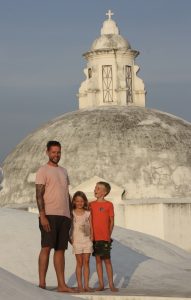 So our ‘entry’ border crossing in 2hrs went pretty smooth but a lot of other travelers spent 6 or more hours at the border. Some have to take all their belongings out of the car. Others are downright turned away and not allowed in the country, because their profession is ‘suspicious’ (journalists, army, etc.). All ‘sings of the times’ of a country that has descended into a dictatorship (again).
So our ‘entry’ border crossing in 2hrs went pretty smooth but a lot of other travelers spent 6 or more hours at the border. Some have to take all their belongings out of the car. Others are downright turned away and not allowed in the country, because their profession is ‘suspicious’ (journalists, army, etc.). All ‘sings of the times’ of a country that has descended into a dictatorship (again).
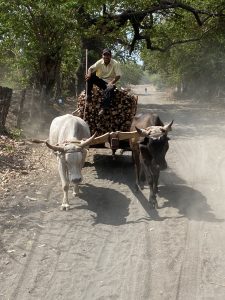 After a very turbulent 20thcentury, Nicaragua’s star started to rise in the beginning of this century. Tourism was booming and the future looked bright. But the old demons returned when president Ortega decide to change the constitution to get another term as president. In 2018, mismanagement of wildfires and a social reform were the cocktail that set the country on fire. Violent protests erupted all over the country. Repression was brutal! From one day to another the tourists stopped flying in and the whole tourism business imploded. The poverty in the country is very obvious these days. As soon as we cross the border, all of a sudden there are only ramshackle little houses, horse (or oxen) carts and bicycles instead of cars and motorbikes. Unfortunately we learn from other travelers that criminality & corruption are also on the rise…
After a very turbulent 20thcentury, Nicaragua’s star started to rise in the beginning of this century. Tourism was booming and the future looked bright. But the old demons returned when president Ortega decide to change the constitution to get another term as president. In 2018, mismanagement of wildfires and a social reform were the cocktail that set the country on fire. Violent protests erupted all over the country. Repression was brutal! From one day to another the tourists stopped flying in and the whole tourism business imploded. The poverty in the country is very obvious these days. As soon as we cross the border, all of a sudden there are only ramshackle little houses, horse (or oxen) carts and bicycles instead of cars and motorbikes. Unfortunately we learn from other travelers that criminality & corruption are also on the rise…
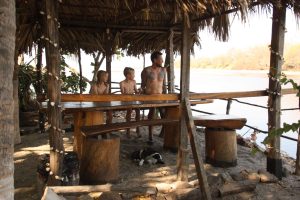 Another thing that is also on the rise, are the temperatures! After our descent from the Guatemalan highlands we were hit by the heat in El Salvador, but Nicaragua is even worse. The host of our first campsite explains us that Nicaragua is the hottest place in Central America and also the country with almost no options to flee to higher (cooler) grounds. And he did not lie! We had planned to spend quite some time surfing the great waves of Nicaragua. The next weeks we make a couple of attempts to stay near the ocean but have to retreat each time after 2 nights.
Another thing that is also on the rise, are the temperatures! After our descent from the Guatemalan highlands we were hit by the heat in El Salvador, but Nicaragua is even worse. The host of our first campsite explains us that Nicaragua is the hottest place in Central America and also the country with almost no options to flee to higher (cooler) grounds. And he did not lie! We had planned to spend quite some time surfing the great waves of Nicaragua. The next weeks we make a couple of attempts to stay near the ocean but have to retreat each time after 2 nights.
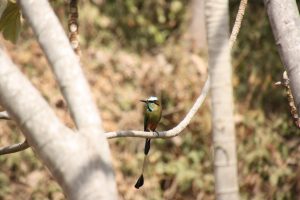 The good news is that after we hardly saw a bird in El Salvador (due to destruction of their habitat and poaching), we are greeted by so many birds at our first camp. Herons, kingfishers but also the beautiful Motmot (Guardabarranco). When we see it the first time we are really enthusiastic thinking we spot a rare bird. People are looking at us a bit strange and tell us that they are actually very common in the country. And indeed, in the next two weeks we see several dozens of these really beautiful birds.
The good news is that after we hardly saw a bird in El Salvador (due to destruction of their habitat and poaching), we are greeted by so many birds at our first camp. Herons, kingfishers but also the beautiful Motmot (Guardabarranco). When we see it the first time we are really enthusiastic thinking we spot a rare bird. People are looking at us a bit strange and tell us that they are actually very common in the country. And indeed, in the next two weeks we see several dozens of these really beautiful birds.
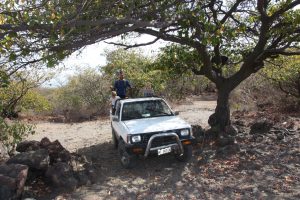 What did not change compared to the previous country is the omni presence of volcanoes. We visit two of them. To get to the first one we drive on a dirt road until at some point we could no longer continue when it changes into a (very rough) 4×4 track. So we find a pick up to take us to the foot of the volcano the next morning. After the very crowded hike on the volcano in El Salvador, this was the complete opposite and we only see 3 other people during the whole hike. At the crater edge we hear the lava bubble but unfortunately there is too much smoke to have a good look. From we top we can see a string of volcanoes as far as we could see both North and South. A reminder that we are driving the biggest part of our trip on the edge of the of the infamous ‘ring of fire’. We had gotten another reminder just a couple of days earlier when we felt the ground shake beneath our feet for about 10 seconds. It was the first time the kids experienced an earthquake. An experience that would trigger a lot of questions such as: “Do you think the Titanic would be able to surf on a tsunami?”
What did not change compared to the previous country is the omni presence of volcanoes. We visit two of them. To get to the first one we drive on a dirt road until at some point we could no longer continue when it changes into a (very rough) 4×4 track. So we find a pick up to take us to the foot of the volcano the next morning. After the very crowded hike on the volcano in El Salvador, this was the complete opposite and we only see 3 other people during the whole hike. At the crater edge we hear the lava bubble but unfortunately there is too much smoke to have a good look. From we top we can see a string of volcanoes as far as we could see both North and South. A reminder that we are driving the biggest part of our trip on the edge of the of the infamous ‘ring of fire’. We had gotten another reminder just a couple of days earlier when we felt the ground shake beneath our feet for about 10 seconds. It was the first time the kids experienced an earthquake. An experience that would trigger a lot of questions such as: “Do you think the Titanic would be able to surf on a tsunami?”
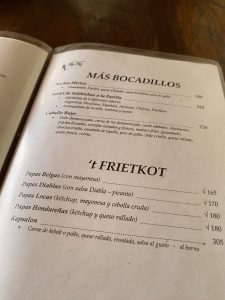 Next stop is the colonial town of Leon. Midday temperature in town is around 44 degrees and for the night the forecast says 35 degrees. We decide to look for a hotel to be able to get some sleep. We visit the cathedral and its very photogenic roof at sunset. The next day we search the Mercado for some fans for ventilation. With these kind of temperatures it is of little surprise that a huge section of the market is dedicated to ‘cooling solutions’. We buy a couple of ‘desktop fans’ (made in China) that will save many nights of sleep in the coming 2 months. We also visit the Via Via travelers café (a Belgian chain of cafés across the world) for a bit of home away from home. Caro really enjoys here Stoofvlees met frietjes!
Next stop is the colonial town of Leon. Midday temperature in town is around 44 degrees and for the night the forecast says 35 degrees. We decide to look for a hotel to be able to get some sleep. We visit the cathedral and its very photogenic roof at sunset. The next day we search the Mercado for some fans for ventilation. With these kind of temperatures it is of little surprise that a huge section of the market is dedicated to ‘cooling solutions’. We buy a couple of ‘desktop fans’ (made in China) that will save many nights of sleep in the coming 2 months. We also visit the Via Via travelers café (a Belgian chain of cafés across the world) for a bit of home away from home. Caro really enjoys here Stoofvlees met frietjes!
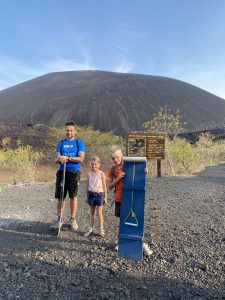 We continue straight to the next volcano Cerro Negro where we plan another hike. Only this time we do not plan to hike back down… The black sand slopes of the volcano make it possible to slide back down on a ‘sandboard’. Something we would like to try of course. We sleep at the bottom of the volcano and hike up first thing in the morning. On our backs Caro and myself each carry a wooden board and protective suits for the whole family. The hike up is gorgeous and the steaming fumaroles remind us that the volcano is still very active. Once at the top we put on our bright green protective suits and get ready to slide down. The kids are not allowed to go alone so both of us take a kid between our legs and try to remember the advice of the rangers to “manage our speed”. Due to the additional weight of the kids it is a bit hard to get speed in the deep sand but once we start to slide…oh dear! The ride only lasts about 20-30 seconds but it was great fun.
We continue straight to the next volcano Cerro Negro where we plan another hike. Only this time we do not plan to hike back down… The black sand slopes of the volcano make it possible to slide back down on a ‘sandboard’. Something we would like to try of course. We sleep at the bottom of the volcano and hike up first thing in the morning. On our backs Caro and myself each carry a wooden board and protective suits for the whole family. The hike up is gorgeous and the steaming fumaroles remind us that the volcano is still very active. Once at the top we put on our bright green protective suits and get ready to slide down. The kids are not allowed to go alone so both of us take a kid between our legs and try to remember the advice of the rangers to “manage our speed”. Due to the additional weight of the kids it is a bit hard to get speed in the deep sand but once we start to slide…oh dear! The ride only lasts about 20-30 seconds but it was great fun.
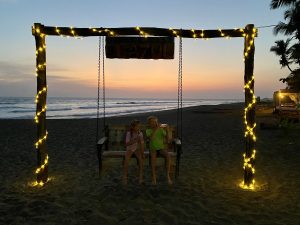 We do another attempt to visit the coast at Las Penitas. This is where the consequences of the Tourism collapse after 2018 are the most visible. A gorgeous beach full of hotels. However at least half of them are in varying states of decay. We camp in the parking lot of a restaurant and during several days we are the only visitors around. We chat with one of the workers of the restaurant about the situation since 2018 and about the poverty. He explains that he has two jobs and his (full time) job at the restaurant earns him 9 USD/day(!), which he says is not considered a bad salary…
We do another attempt to visit the coast at Las Penitas. This is where the consequences of the Tourism collapse after 2018 are the most visible. A gorgeous beach full of hotels. However at least half of them are in varying states of decay. We camp in the parking lot of a restaurant and during several days we are the only visitors around. We chat with one of the workers of the restaurant about the situation since 2018 and about the poverty. He explains that he has two jobs and his (full time) job at the restaurant earns him 9 USD/day(!), which he says is not considered a bad salary…
We had planned another volcano visit but unfortunately the Masaya volcano is closed to the public during our time in Nicaragua. A part of the crater rim has collapsed into the ‘lava lake’ and the scientists monitoring the volcano see gas pressure rising and expect it to ‘expulse the debris. We have a look at the volcano from the highway on our way to Granada.
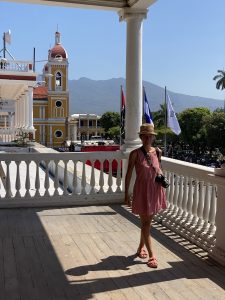 Another colonial town that gets great reviews from travelers. Granada is a beautiful town for sure but we actually liked Leon better. It felt a bit more like our hometown while Granada would be the Nicaraguan Bruges. But maybe that’s just because of all the horse drawn carriages for tourists. We did really like the chocolate museum…especially the tasting. Another highlight for Leon was our parking spot with the local firemen (Bomberos). One of the firemen shows him around and he even gets to try on their gear.
Another colonial town that gets great reviews from travelers. Granada is a beautiful town for sure but we actually liked Leon better. It felt a bit more like our hometown while Granada would be the Nicaraguan Bruges. But maybe that’s just because of all the horse drawn carriages for tourists. We did really like the chocolate museum…especially the tasting. Another highlight for Leon was our parking spot with the local firemen (Bomberos). One of the firemen shows him around and he even gets to try on their gear.
We leave the city to sleep by the Laguna de Apoyo, a lake in a collapsed volcano. We were just looking to cool off a bit but discover a true bird paradise. Herons, eagles, motmots and parrots are all around but most memorable are the divebombing kingfishers that we see dive for fish from trees all around us.
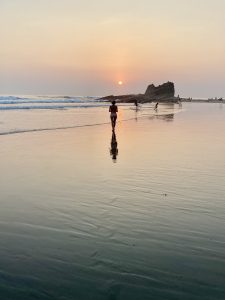 Our last stop in Nicaragua was supposed to be the Omotope island in lake Nicaragua but when we arrive at the ferry dock, we are told that all ferries are booked for the next 10 days. It is Semana Santa (Easter holidays) and the government has forbidden all processions and other public religious events (they fear that these can spark new protests). As a result everybody is heading to the beaches and islands around the country. We quickly come up with a back up plan and drive to a beach town that is a bit more remote and hope to find a place to sleep. We find a spot with a nice swimming pool near the town of Popoyo. The beach is gorgeous and there are several really good surf spots for all levels. This is where for the first time, I’m not being pummeled by big waves and really start having fun on the board again. Unfortunately the heat and humidity are really intense again. It is now really the end of the dry season. All trees are bare. There is no shade to be found. And it seems that everything that still lives (including ourselves), is just busy trying to survive another day/night. As much as we like this place, we can’t support the heat for another night. So earlier than planned, we decide to move on to Costa Rica.
Our last stop in Nicaragua was supposed to be the Omotope island in lake Nicaragua but when we arrive at the ferry dock, we are told that all ferries are booked for the next 10 days. It is Semana Santa (Easter holidays) and the government has forbidden all processions and other public religious events (they fear that these can spark new protests). As a result everybody is heading to the beaches and islands around the country. We quickly come up with a back up plan and drive to a beach town that is a bit more remote and hope to find a place to sleep. We find a spot with a nice swimming pool near the town of Popoyo. The beach is gorgeous and there are several really good surf spots for all levels. This is where for the first time, I’m not being pummeled by big waves and really start having fun on the board again. Unfortunately the heat and humidity are really intense again. It is now really the end of the dry season. All trees are bare. There is no shade to be found. And it seems that everything that still lives (including ourselves), is just busy trying to survive another day/night. As much as we like this place, we can’t support the heat for another night. So earlier than planned, we decide to move on to Costa Rica.
We heard that the Nicaragua exit border crossing is sometimes even harder than the entry but we do not have any issues this time either. No scanner needed. Just a lot of paperwork and again fees for just about everything (fee for entry of the customs building, fee for a document, fee for a stamp, etc.) but after that we are ‘free to go’.
